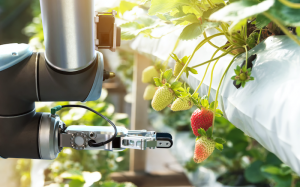Robot-plant bio-hybrids may ensure the sustainable development of smart cities

While, for many, the past will always hold the appeal of a life that was simpler and closer to nature, the progress of science and technology has allowed mankind to significantly extend the lifespan of its species over the course of just a few generations. Illnesses that were once mortal can now be cured. Research continues not only to identify new antidotes to a variety of health issues, but also shows us how to prevent many illnesses. Indeed, much to the chagrin of dystopians and luddites around the world, technology has done much to improve our lives.
Urbanisation
For many decades, the global increase in urbanisation stood as a symbol of this wayward route towards pollution and perdition, but life in cities is improving, and rather quickly. Metropolises around the world are growing greener. City councils are planting more trees and opening more parks. And, of course, smart technological solutions are being developed around the globe to reduce pollution and promote environmental sustainability.
Moreover, telematics has allowed us to introduce intelligent parking lots, smart traffic lights that divert traffic to less congested routes, and smart public illumination systems that automatically adjust to environmental light. Cities are also clamping down on private transport and promoting public transport and TNCs to improve air quality, reduce noise and eliminate the conditions that provoke stress and cause illness. Indeed, it will not be long before fleets of shared self-driving cars fuelled by clean energies will transport passengers around, without ever standing idle, virtually eliminating the need for parking spaces. And many of the parking areas that were once devoted to vehicles will be transformed into green areas, too.
Domotics
Similarly, domotics promises to expand the adoption of clean, sustainable and efficient energetic consumption in our living and working areas. Our houses and offices are becoming greener, more permeable to natural sunlight and as seamless as possible with the natural environment outside. It’s a trend based on biophilia, the natural human instinct to want to be closer to nature. Indeed, studies have proven that natural environments and sunlight reduce stress, improve our overall health, and increase concentration and acumen.
Eco-Sustainability
As our cities continue to grow greener and greener with the development of vertical gardens and the construction of self-sustainable buildings, researchers have begun to investigate the relationship between plants and the intelligent technology that has become a part of our everyday lives. Traditionally, the green architectural model has been to develop buildings made with low-impact, eco-sustainable materials, surrounded by gardens with plants and trees; the plants and gardens were integrated into the buildings themselves with the creation of vertical biomes. Now, researchers are beginning to address a ground-breaking experiment: can the plants themselves become the building?
Robots and Plants
Enter Flora Robotica, a project that has received 3.6 million euro in financing from the European Union’s Horizon 2020 Research and Innovation Programme. Project Flora Robotica aims to develop and investigate plant-robot symbiosis for the production of architectural structures. In a nutshell, the idea is to allow miniaturised robots to monitor, drive and interact directly with plant growth.
Plants and robots are very different; this, however, makes them ideal partners, perfect for symbiosis, a relationship in which two species do not compete, but cooperate. Plants grow slowly. They have no brain or nervous system. Robots, on the other hand, are driven by artificial intelligence and are fast. Together, they could be extraordinary.
These robotic assemblies exploit plant tropism. They support and control plants by providing the structure, water, nutrients and lighting necessary to direct the growth of the plant. The robot-plant systems grow together and form a closely co-dependent and self-organized system that is connected to the Internet. The final result is a smart, biological, architectural structure, that provides shade, air quality control, and stress relief. And the structure is connected directly to the Internet of Things; indeed, it will have been throughout its development. Add machine learning and artificial intelligence to the mix and the future potential is nothing short of astounding.
While, in the short-term, the application of these robot-plant bio-hybrids may be employed to create simple, yet appealing, natural architectural features, such as benches and walls, the long-term vision is to enable the development of adaptable, self-growing, and self-repairing residential structures. And looking even further into the future, this very technology could be employed for the erection of oxygen-creating infrastructure for research outposts on planets such as Mars.
Who said that technology is not green?